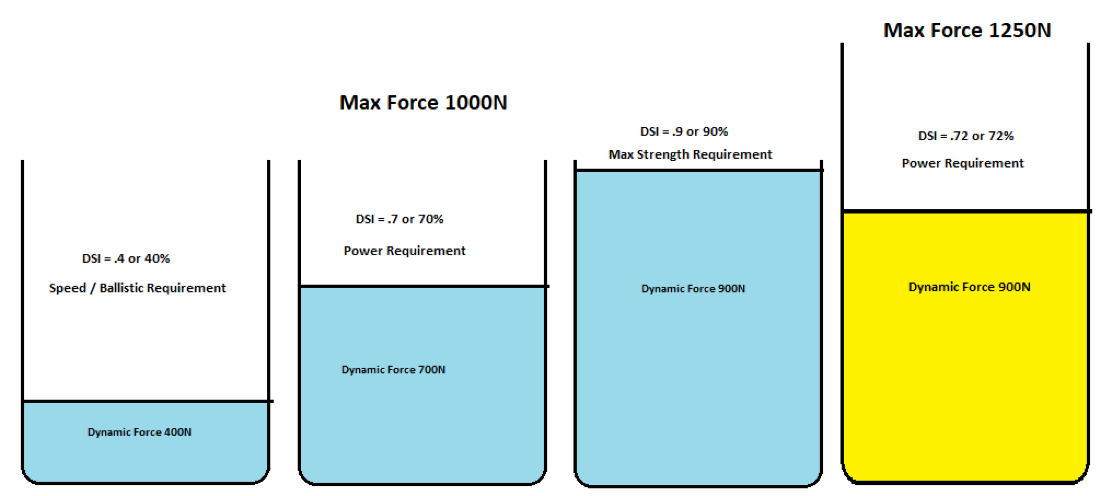In my last post, I discussed the importance of understanding an athlete’s needs and goals before building a training program for them. The Dynamic Strength Index is one tool we use to determine whether an athlete needs to improve their strength, power or speed. It’s a relatively simple assessment ideal for younger athletes or those with less strength and conditioning experience.
Today, I will explain how the DSI works, what results mean, and how it can help decide what type of training program will yield the best results for an athlete.
Maximum Potential vs. Peak Force
Your performance depends on two key factors: how much potential power your body has and how well you can access that power. Picture your potential power as a bucket — the higher your maximum output, the bigger your bucket. Your ability to access that power correlates to how much you can fill that bucket.
Experienced athletes know that all the strength training and conditioning in the world won’t help if you can’t access all that power at the critical moment. The Dynamic Strength Index helps us measure the size of your bucket and your ability to fill it to identify where improvements will deliver the most value. It’s not a question of strong or weak — it’s about how much of your strength is accessible when you need it.
Using the Dynamic Strength Index
There are two steps to testing an athlete’s strength potential with the DSI.
- Assess the maximum force output in an isometric mid-thigh pull. This reveals the athlete’s maximum strength potential (or how big their bucket is).
- Measure the peak force in a dynamic movement like a counter-movement jump. This shows how much of the athlete’s strength is accessible (or how much they can fill their bucket).
The ratio between the two measurements can inform what a new training program should focus on.

Translating DSI Scores into Training Insights
Determining your Dynamic Strength Index score is a vital first step in deciding where to focus your training. But what do those ratios really mean?
Let’s go back to the bucket example I used earlier. This diagram represents athletes with different maximum and dynamic force levels. You can see that merely having a bigger bucket (or more potential strength) doesn’t automatically equal better performance or a higher score.

1. Ballistic Requirement
The bucket on the left represents an athlete with a maximum force output of 1000 Newtons and a dynamic force output of 400N, or a DSI of 0.4.
What It Means: This athlete can utilize 40% of their maximum strength when moving dynamically, leaving 60% of their potential power untapped.
Next Steps: Strength training won’t help this athlete improve their performance — they already have plenty of strength they aren’t using. Their training program should focus on ballistic training, which will help increase their dynamic power while maintaining their maximum strength at existing levels.
2. Power Requirement
The second bucket represents an athlete with the same max force output as the first (1000N), but a better expression of this force at 700N, or a DSI of 0.7.
What It Means: This athlete can access more of their potential power during dynamic movement than the first example. They are utilizing 70% of their potential.
Next Steps: Focusing entirely on ballistic training could quickly get this athlete using nearly all of their potential power, but their performance would plateau again quickly once they did. A training program for this athlete should hit both ends of the spectrum, strength and speed, to help increase maximum potential and their ability to use it. A power development program alternating between ballistic and strength training is ideal in this case.
3a. Strength Requirement
The third bucket represents an athlete with the same max force output as the previous two (1000N) but an amazing dynamic expression of 900N and a DSI of 0.9.
What It Means: This athlete is utilizing nearly all their power — so it’s time for them to increase the size of their bucket!
Next Steps: It’s time for this athlete to increase their maximum strength potential while maintaining their dynamic force output. Training for this athlete should focus on building more strength to boost their max force output.
3b. Strength to Power Requirement
The final bucket is a representation of the third athlete after spending four to six weeks on a training program aimed at building strength. As you can see, their dynamic force output remains at 900N, but their maximum force has climbed to 1250N, giving them an updated DSI of 0.72 (similar to the athlete in the second bucket).
At this point, a program like that outlined in example two makes sense — this athlete’s next block of training should focus on helping them unlock the new power they’ve developed.
Improve Your Performance with Scienced Athletics
Understanding how and where to use the Dynamic Strength Index is an important first step on your journey toward optimal athletic performance — and a great illustration of why one-size-fits-all training programs rarely deliver the results you want.
At Scienced Athletics, we build custom programs for athletes of all ages and skill levels, based entirely on a scientific approach to physical fitness. If you still have questions about DSI, get in touch with our team today. Want to know more about our approach to training? Book a complimentary, no-obligation consultation now.




